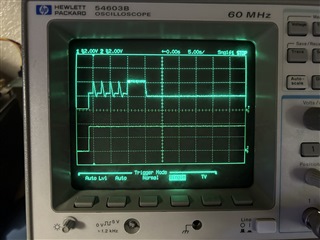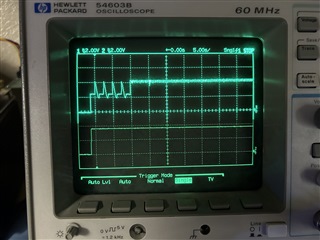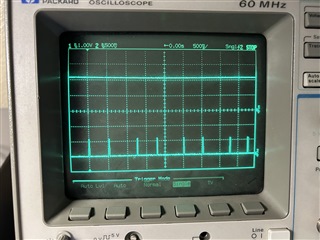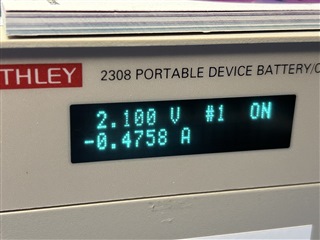Other Parts Discussed in Thread: BQ40Z50, BQ25798, BQSTUDIO
Tool/software:
Hi there—our design comprises the BQ25798 with a 1S4P battery pack that uses the BQ40Z50 for primary protection. The BQ40Z50 is configured with the following parameters in our application:
- CUV threshold = 2700 mV
- Shutdown threshold = 2600 mV
- Charger present threshold = 2250 mV
- SUV threshold = 2000 mV
- SUV delay = 5 seconds
- SUV_MODE = 1
- ZVCHG threshold = 1800 mV
I have replaced the cells in the battery pack with a Keithley 2308 cell simulator to test the interaction between the BQ25798 and the BQ40Z50 during various conditions. The regulated output of the Keithley 2308 is referred to as VCELL in the notes below.
Our system can charge normally for VCELL above 2.0 V, and SUV PF engages for VCELL below 2.0 V. However, I have a couple points of confusion regarding the startup and shutdown conditions of the gauge:
[1] For VCELL = 2.1 V, we see the following waveform at VPACK (channel 1) when a charger is inserted:

The behavior shown here is normal, and can be described as:
- 10% through 30% time division: the BQ25798 repeatedly disables and re-enables VPACK because the CHG FET is open at the beginning of the SUV delay, and the BQ25798 thinks charging has terminated. The BQ40Z50 keeps being reset before the SUV delay can complete.
- 30% time division: our system firmware intervenes and reduces the charging termination debounce time, so the BQ25798 can hold VPACK steady.
- 30% through 40% time division: the BQ40Z50 waits for the SUV delay to expire.
- 40% time division: the BQ40Z50 closes the CHG FET, and charging proceeds normally with VPACK = VCELL = 2.1 V. The cell simulator display confirms the cell is drawing the expected precharge current (500 mA in our application).
Originally, I feared that the gauge would shut down at 40% time division because VPACK is less than the charger present threshold, and VCELL is less than the shutdown voltage. To my relief, however, the gauge stays awake and the CHG FET can stay closed.
What is keeping the gauge awake in this case? Is there some other condition (charge current flowing?) during which the gauge will avoid shutting down? To be clear, what we're seeing here is desired behavior—I just want to make sure there are no other flash parameters we need to set to ensure this behavior can be consistent.
[2] I disabled SUV PF, then repeated my test with VCELL lowered to 1.9 V; the result looks similar to below:

In this case, the CHG FET never closes and the cell cannot charge. This is ultimately not a problem, since we would normally trigger SUV at this level of VCELL anyway.
I can still communicate with the gauge over I2C, since VPACK is close to 4.4 V. The gauge reports the following values during this time:
- SafetyStatus (0x51): 0x01 0x00 0x00 0x00 (CUV = 1)
- PFStatus (0x53): 0x00 0x00 0x00 0x00 (none)
- OperationStatus (0x54): 0x81 0x6d 0x00 0x00 (XCHG = XDSG = SS = SDV = 1)
It seems that whatever mechanism keeps the gauge awake during [1] finally drops out once VCELL approaches 2.0 V. If the gauge can keep the CHG FET closed at VPACK = VCELL = 2.1 V, why can't it do the same for VPACK = 4.4 V?
Thank you in advance for your support—in case I can clarify any of my questions or observations, please let me know.





